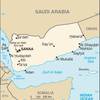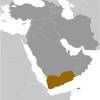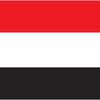Yemen [+]Compare [E]dit [H]istory
Aliases: Al Jumhuriyah al Yamaniyah, Al Yaman, Republic of Yemen, Yemen Arab Republic [Yemen (Sanaa) or North Yemen] and People's Democratic Republic of Yemen [Yemen (Aden) or South Yemen]Object «Yemen» was created due to
Add new object to «Yemen» or move existing objects here.
Object «Yemen» has attributes [Show empty attributes][Hide empty attributes]
| Attribute | Value |
|---|---|
| Geography | |
| Area | 527,968 km² |
| Continent | Asia |
| Land area | 527,968 km² |
| Water area | 0 km² |
| Land boundaries | 1,601 km |
| Border countries |
|
| Coastline | 1,906 km |
| Mean elevation | 999 m |
| Lowest point | 0 m |
| Highest point | 3,666 m |
| People | |
| Population | 29,884,405 |
| Official languages |
|
| Religion | Muslim |
| Government | |
| Long country name | Republic of Yemen |
| Short country name | Yemen |
| Long local name | Al Jumhuriyah al Yamaniyah |
| Short local name | Al Yaman |
| Former name |
|
| Government type | In transition |
| Capital | Sanaa |
| Economy | |
| GDP (PPP) | 73,630,000,000 USD |
| GDP (OER) | 31,270,000,000 USD |
| GDP (real growth rate) | -5.9 % |
| GDP - per capita (PPP) | 2,500 USD |
| Gross national saving | -1.9 % of GDP |
| Labor force | 7,425,000 |
| Unemployment rate | 27 % |
| Population below poverty line | 54 % |
| Budget revenues | 2,821,000,000 USD |
| Budget expenditures | 4,458,000,000 USD |
| Military expenditures | 3.98 % of GDP |
| Taxes and other revenues | 9 % of GDP |
| Budget surplus or deficit | -5.2 % of GDP |
| Public debt | 74.5 % of GDP |
| Inflation rate | 24.7 % |
| Central bank discount rate | Add |
| Commercial bank prime lending rate | 30 % |
| Stock of narrow money | 4,736,000,000 USD |
| Stock of broad money | 4,736,000,000 USD |
| Stock of domestic credit | 2,326,000,000 USD |
| Market value of publicly traded shares | Add |
| Current account balance | -1,236,000,000 USD |
| Exports | 384,500,000 USD |
| Imports | 4,079,000,000 USD |
| Reserves of foreign exchange and gold | 245,400,000 USD |
| External debt | 7,068,000,000 USD |
| National currency | Yemeni rials |
| National currency (code) | YER |
| National currency (symbol) | ﷼ |
| National currency rate to USD | 275 |
The Kingdom of Yemen (colloquially known as North Yemen) became independent from the Ottoman Empire in 1918 and in 1962 became the Yemen Arab Republic. The British, who had set up a protectorate area around the southern port of Aden in the 19th century, withdrew in 1967 from what became the People's Republic of Southern Yemen (colloquially known as South Yemen). Three years later, the southern government adopted a Marxist orientation and changed the country's name to the People's Democratic Republic of Yemen. The massive exodus of hundreds of thousands of Yemenis from the south to the north contributed to two decades of hostility between the states. The two countries were formally unified as the Republic of Yemen in 1990. A southern secessionist movement and brief civil war in 1994 was quickly subdued. In 2000, Saudi Arabia and Yemen agreed to delineate their border. Fighting in the northwest between the government and the Huthis, a Zaydi Shia Muslim minority, continued intermittently from 2004 to 2010, and then again from 2014-present. The southern secessionist movement was revitalized in 2007. Public rallies in Sana'a against then President Ali Abdallah SALIH - inspired by similar demonstrations in Tunisia and Egypt - slowly built momentum starting in late January 2011 fueled by complaints over high unemployment, poor economic conditions, and corruption. By the following month, some protests had resulted in violence, and the demonstrations had spread to other major cities. By March the opposition had hardened its demands and was unifying behind calls for SALIH's immediate ouster. In April 2011, the Gulf Cooperation Council (GCC), in an attempt to mediate the crisis in Yemen, proposed the GGC Initiative, an agreement in which the president would step down in exchange for immunity from prosecution. SALIH's refusal to sign an agreement led to further violence. The UN Security Council passed Resolution 2014 in October 2011 calling for an end to the violence and completing a power transfer deal. In November 2011, SALIH signed the GCC Initiative to step down and to transfer some of his powers to Vice President Abd Rabuh Mansur HADI. Following HADI's uncontested election victory in February 2012, SALIH formally transferred all presidential powers. In accordance with the GCC Initiative, Yemen launched a National Dialogue Conference (NDC) in March 2013 to discuss key constitutional, political, and social issues. HADI concluded the NDC in January 2014 and planned to begin implementing subsequent steps in the transition process, including constitutional drafting, a constitutional referendum, and national elections. The Huthis, perceiving their grievances were not addressed in the NDC, joined forces with SALIH and expanded their influence in northwestern Yemen, culminating in a major offensive against military units and rival tribes and enabling their forces to overrun the capital, Sanaa, in September 2014. In January 2015, the Huthis surrounded the presidential palace, HADI's residence, and key government facilities, prompting HADI and the cabinet to submit their resignations. HADI fled to Aden in February 2015 and rescinded his resignation. He subsequently escaped to Oman and then moved to Saudi Arabia and asked the GCC to intervene militarily in Yemen to protect the legitimate government from the Huthis. In March, Saudi Arabia assembled a coalition of Arab militaries and began airstrikes against the Huthis and Huthi-affiliated forces. Ground fighting between Huthi-aligned forces and resistance groups backed by the Saudi-led coalition continued through 2016. In 2016, the UN brokered a months-long cessation of hostilities that reduced airstrikes and fighting, and initiated peace talks in Kuwait. However, the talks ended without agreement. The Huthis and SALIH’s political party announced a Supreme Political Council in August 2016 and a National Salvation Government, including a prime minister and several dozen cabinet members, in November 2016, to govern in Sanaa and further challenge the legitimacy of HADI’s government. However, amid rising tensions between the Huthis and SALIH, sporadic clashes erupted in mid-2017, and escalated into open fighting that ended when Huthi forces killed SALIH in early December 2017. In 2018, anti-Huthi forces made the most battlefield progress in Yemen since early 2016, most notably in Al Hudaydah Governorate. In December 2018, the Huthis and Yemeni Government participated in the first UN-brokered peace talks since 2016. In April 2019, Yemen’s parliament convened in Seiyoun for the first time since the conflict broke out in 2014 and elected a speaker and vice speakers.
Similar objects
Most often compared with
Everyone can something to edit or add.
There were 2 edits, no edits waiting approval. Last edited by Guest_1198(-47), May 26, 2020 (49 fields were changed)
Help · Contact us · Disclaimer · Contributors · Developers · Donate


